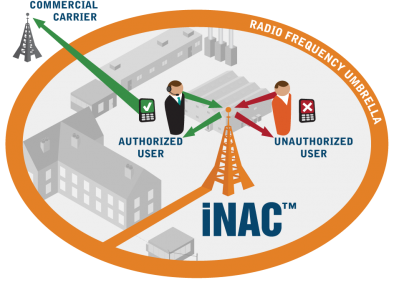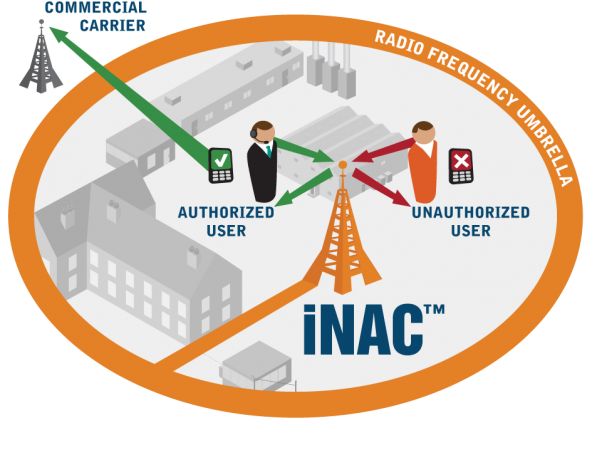iNAC® Managed Access
Control Wireless Communications
Overview
The challenge posed by controlling communications is the delicate balance between managing coverage throughout the target area without impacting the commercial networks that exist on the other side of the border – in many cases just feet away. Balancing the overwhelming build-out of commercial network capacity with a controlled communications environment is a complex challenge. Tecore’s ability to utilize the same technology as the commercial wireless networks – to create a credible countermeasure across the spectrum of wireless technologies deployed – provides a comprehensive and cost-effective solution to prevent unauthorized communications.

Learn More
Managed Access 101
iNAC Success Elements
Patented Technology
Managed Access 101
The concept of Managed Access is actually quite simple. Wireless devices leverage protocols and technologies to exchange information with their commercial networks. Most devices today support a combination of technologies across 2G, 3G and 4G LTE. As a cell phone moves from one area to the next, the device selects the best technology and channel for communication. Information is then exchanged between the device and network to provide service to the user. Once a network accepts a device, the device is allowed access and “camps” on the local signal broadcast by the network. Subsequent access to place a call, send a text message, or access the internet is all initiated through communications over this channel.
The Managed Access System (MAS) works from the same principles. It attracts and provides the device service the same way the commercial network does. When a device enters the coverage area of the Managed Access network, the device is compelled to communicate as if it was still on the commercial network. Once the device accesses the MAS network, it is determined whether the device is a known authorized device or an unknown, contraband device. Depending on the identification of the device, treatment while on the MAS is as follows:
- For unknown, contraband devices on the system, any subsequent action is met with denial. While the device still appears to be on the commercial network, access to the actual commercial network is denied.
- For authorized devices, the MAS system redirects them to the actual commercial network allowing these approved devices to continue to maintain access to their commercial service.
Through this basic logic, MAS provides the appropriate balance between control of contraband while permitting approved users to continue to use their device in the same controlled space.

Technology Coverage
The iNAC manages the current technologies deployed by the wireless industry. It is the only proven Managed Access System in the market that has evolved through 2G, 3G, 4G, and now WiFi and 5G. The software-defined radio architecture and flexibility of the power amplification system has allowed continued support, while the surrounding commercial wireless technology evolves. Even as new networks and technologies lurk on the horizon, Tecore’s iNAC system is ready to support.
Spectrum Band Coverage
The iNAC supports the current bands where wireless technologies are deployed. Maintaining support for the entire deployed spectrum is an ongoing challenge that requires system infrastructure that is prepared for the future.
Upgradability
While the iNAC addresses the two listed items above, the baseline architecture is also flexible enough to anticipate changes that can impact the deployed infrastructure. With 5G and the Internet of Things (IoT) now a reality, being able to adapt the solution to the changing landscape of wireless is key for continued success of a MAS deployment.
Indoor Antenna System
The distribution of RF energy indoors for small to large coverage areas can be resolved by deploying a fiber-based distributed antenna system (DAS). The signals are then distributed by multiple antennas throughout the coverage areas.
Outdoor Antenna System
Outdoor solutions are applicable for larger facilities or coverage areas. This type of deployment operates at a higher RF power and can utilize existing structures.
Installation Flexibility
The iNAC has been installed in urban, as well as rural facilities. While the core technology remains the same, the architecture of the infrastructure required to build the appropriate RF umbrella is significantly different.
RF Deployment Flexibility
No two installations are identical, which impacts the methods and equipment set required to create the proper RF footprint for the institution. Additionally, the surrounding area can also impact the required equipment set, based on the level of control of the MAS signals needed to obtain the proper balance with the commercial networks outside the wall. iNAC is the proven Managed Access System when considering successful deployments in various, challenging operational environments.
Emergency Support
While the basic MAS technology concept provides a basic decision mechanism of an approved or unapproved device, there are unique cases where exceptions need to be made. For example, in many locations in the U.S. and around the world, the system must support an override capability for emergency calls (911 or 112). In this case – regardless of the device’s status – the call is allowed to complete. This support provides compliance in areas where blocking of emergency calls is illegal or otherwise prohibited. Additionally, the iNAC supports the Communications Assistance for Law Enforcement Act (CALEA) for lawful intercept in accordance with court orders or applicable laws.
Patented Technology
The Tecore Networks iNAC Managed Access is based on a solid foundation of patented technology. As a wireless network infrastructure provider, Tecore created the MAS from a cellular-based solution. Given almost 30 years of experience in deploying intricately designed networks, Tecore has been the leader in transiting knowledge of wireless networks to effectively prevent illegal communications before they occur. Tecore’s Intelligent Network Access Controller (iNACTM) Managed Access System (MAS) achieves the appropriate balance between communications control within the walls of an institution and a harmonized deployment with the surrounding commercial wireless networks. The solution leverages Multi-Technology wireless support, as well as the methods of access control outlined in the nine specific Managed Access related patents Tecore holds.
The following list of patents outlines the targeted capability of Tecore’s Managed Access System:
- 6,912,230: Multi-protocol Wireless Communications Apparatus and Method
- 7,733,901: Multi-protocol Wireless Communications Apparatus and Method
- 8,254,886: Intelligent Network Access Control and Method
- 8,437,741: Intelligent Network Access Control and Method
- 8,509,740: Intelligent Network Access Control and Method
- 8,825,011: Intelligent Network Access Control
- 9,295,071: Intelligent Network Access Control and Method
- 9,332,412: Intelligent Network Access Control
- 9,526,021: Intelligent Network Access Control and Method
- 9,712,539: Intelligent Network Access Control
- 9,712,540: Intelligent Network Access Control and Method
- 10,057,774: Intelligent Network Access Control and Method
- 10,063,566: Intelligent Network Access Control
- 10,469,506: Systems and Methods for Communication Control in a Restricted Environment
- 10,673,865: Systems and Methods for Communication Control in a Restricted Environment
- 10,679,381: Intelligent Network Access Control
- 10,679,382: Intelligent Network Access Control
- 10,771,474: Systems and Methods for Communication Control in a Restricted Environment
Key Benefits
Avert
Prevent unauthorized communications before they occur
Comprehensive
Addresses not only cell phones, but subscriber identity module (SIM) cards
Cost-Effective
Avoidance of resource-intensive measures to manually locate and retrieve devices
Interoperability
Secured Wi-Fi and Interoperability for Emergency Communications (P25 support)
